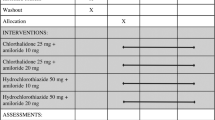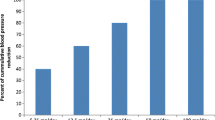Summary
The antihypertensive, saluretic and hypokalaemic effects of a small dose of cyclothiazide (2.5 mg daily) were compared with those of a conventional dose of an hydrochlorthiazide-amiloride hydrochloride combination (50+5 mg daily). Both preparations were given to 13 patients with mild (WHO I) hypertension in a cross-over manner for six weeks, with an intervening wash-out phase of three weeks. The antihypertensive efficacy of cyclothiazide was well comparable to that of the hydrochlorthiazide-amiloride combination, although cyclothiazide tended to inhibit renal sodium reabsorption less than the combination. Cyclothiazide tended to cause hypokalaemia, apparently due to increased potassium loss, but with the present dosage none of the 13 patients developed marked hypokalaemia (serum potassium less than 3.3 mmol/l). Both drugs led to a comparable increase in serum urate concentration. Neither of the preparations affected creatinine or free-water clearance. The results suggest that even in relatively small doses thiazides effectively decrease blood pressure, and combining thiazides with potassium-sparing diuretics is advantageous only in patients with marked hypokalaemia and its associated risks.
Similar content being viewed by others
References
Bengtsson C, Johnsson G, Sannerstedt R, Werkö L (1975) Effect of different doses of chlorthalidone on blood pressure, serum potassium and serum urate. Br Med J 1: 197–199
Berglund G, Andersson O (1975) Low doses of hydrochlorthiazide in hypertension. Antihypertensive and metabolic effects. Eur J Clin Pharmacol 10: 177–182
Brater DC, Thier SO (1978) Renal disorders. In: Melmon KL, Morelli HF (eds) Clinical Pharmacology. 2nd ed. Macmillan, New York, pp 349–387
Clark LC Jr, Thompson HL (1949) Determination of creatine and creatinine in urine. Anal Chem 21: 1218
Davies DL, Wilson GM (1975) Diuretics: Mechanism of action and clinical application. Drugs 9: 178–226
Degnbol B, Dorph S, Marner T (1973) The effect of different diuretics on elevated blood pressure and serum potassium. Acta Med Scand 193: 407–410
Hansson L, Hood B (1977) Antihypertensiva medel. Socialstyrelsens kommitté för läkemedelsinformation No. 2: 1
Kassirer JP, Marrington JT (1977) Diuretics and potassium metabolism: A reassesment of the need, effectiveness and safety of potassium therapy. Kidney Int 11: 505–515
Lake CR, Ziegler MC, Coleman MD, Kopin IJ (1979) Hydrochlorthiazide-induced sympathetic hyperactivity in hypertensive patients. Clin Pharmacol Ther 26: 428–432
Lawrence DR, Bennet PN (1980) Diuretics, oedema, urinary pH. In: Clinical Pharmacology, 5th ed. Churchill Livingstone, Edinburgh, pp 674–694
Leemhuis MP, Struyvenberg A (1973) Significance of hypokalemia due to diuretics. Neth J Med 16: 18–28
Materson BJ, Oster JR, Michael UF, Bolton SM, Burton ZC, Stambaugh JE, Morledge J (1978) Dose response to chlorthalidone in patients with mild hypertension. Clin Pharmacol Ther 24: 192–198
Mudge GH (1980) Diuretics and other agents employed in the mobilization of edema fluid. In: Goodman Gilman A, Goodman LS, Gilman A (eds) The Pharmacological basis of therapeutics, 6th ed. Macmillan, New York, pp 892–915
Pitkäjärvi T, Ala-Laurila P, Ruosteenoja R, Torsti P, Masar S-E (1977) Treatment of hypertension with successive use of a diuretic, clonidine or a beta-blocking agent and hydralazine. Eur J Clin Pharmacol 12: 161–165
Rose GA, Blackburn H (1968) Cardiovascular survey methods. WHO, Geneva
Simpson FO (1980) Hypertensive disease. Pharmacodynamics and pharmacokinetics in practical therapy. Diuretics. In: Avery GS (ed) Drug treatment. Principles and practice of clinical pharmacology and therapeutics, 2nd ed. ADIS, Sydney, pp 648–649
Wilhelmsson CE, Vedin JA, Moerlin C, Lund-Johansen P, Vorburger C, Enenkel W, Lutterbeck PM, Bolognese J, Cirillo VJ, Tempero KF (1979) A double-blind comparison of a novel indanone diuretic (MK-196) with hydrochlorthiazide in the treatment of essential hypertension. Br J Clin Pharmacol 8: 261–266
Author information
Authors and Affiliations
Rights and permissions
About this article
Cite this article
Salonen, J.T., Ylitalo, P. Antihypertensive, saluretic and hypokalaemic effects of cyclothiazide in comparison with hydrochlorthiazide with amiloride supplement. Eur J Clin Pharmacol 22, 495–499 (1982). https://doi.org/10.1007/BF00609621
Received:
Accepted:
Issue Date:
DOI: https://doi.org/10.1007/BF00609621




